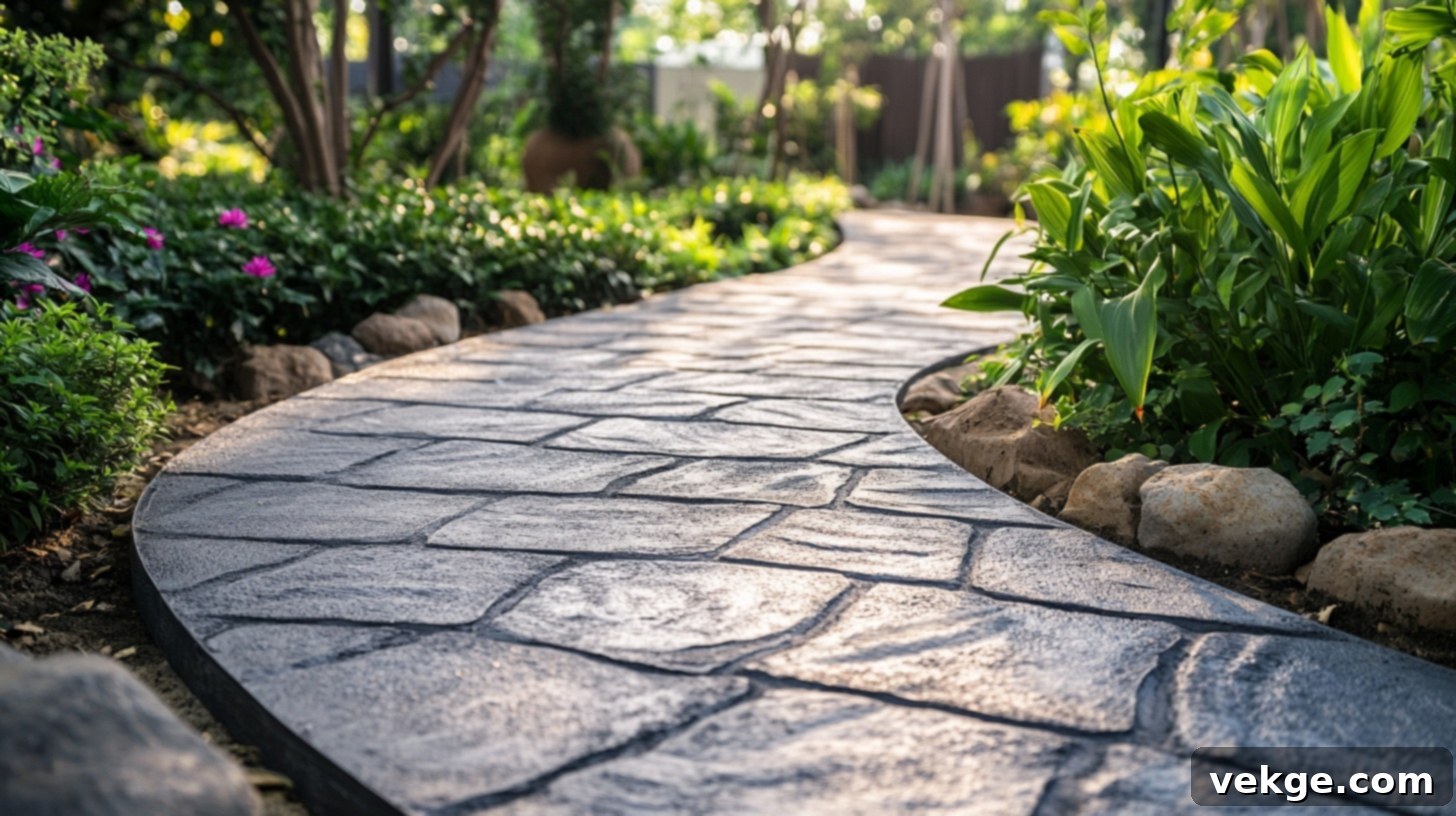Transform Your Outdoors: 15 Stunning Stamped Concrete Walkway Ideas & Expert Tips for Lasting Beauty
Have you ever looked at your existing outdoor paths or a dull, uninspired stretch leading to your front door and thought, “This space has so much more potential”? I certainly have. Like many homeowners, I dreamed of a beautiful, inviting pathway that enhanced my home’s curb appeal without requiring an exorbitant budget or endless maintenance.
That’s when I discovered the incredible versatility and value of a **stamped concrete walkway**. Far more than just plain concrete, this innovative solution allows you to replicate the luxurious look of natural stone, classic brick, or even rustic wood, all while enjoying the inherent durability and cost-effectiveness of concrete. It’s a game-changer for transforming mundane paths into captivating architectural features.
In this comprehensive guide, we’ll dive deep into what makes a stamped concrete walkway such a smart investment. I’ll share an abundance of creative design ideas, practical tips, and essential advice to help you envision and create your perfect outdoor pathway. Whether you’re aiming for a charming garden path or an elegant front entrance, prepare to be inspired.
Ready to turn that overlooked path into a true extension of your home’s style and charm? Let’s explore some easy, fun, and highly effective ways to enhance your outdoor living space with stamped concrete.
Why Choose a Stamped Concrete Walkway for Your Home?
Stamped concrete walkways stand out as an exceptionally smart choice for homeowners seeking a blend of aesthetic appeal, long-term durability, and budget-friendly installation. Their popularity isn’t just a trend; it’s a testament to their numerous practical advantages over traditional paving materials.
One of the primary reasons to opt for stamped concrete is its remarkable ability to mimic high-end materials. Imagine a walkway that boasts the intricate patterns of brick, the rugged elegance of natural stone, or the warm texture of wood planks – all crafted from durable concrete. This means you can achieve that premium, designer look without the hefty price tag associated with sourcing, transporting, and laying individual natural stones or bricks. The cost savings can be significant, making luxury aesthetics accessible.
Beyond its impressive visual versatility, stamped concrete is engineered for strength and longevity. Unlike individual pavers that can shift, loosen, or sprout weeds in their joints, a stamped concrete pathway forms a continuous, solid surface. This robust construction allows it to withstand diverse weather conditions, from heavy rain and snow to extreme heat and cold, without cracking, settling, or deteriorating rapidly. You’ll spend less time and money on frequent repairs, enjoying a consistently beautiful path for many years.
Furthermore, maintaining a stamped concrete walkway is incredibly straightforward. Its solid, sealed surface means no annoying weeds pushing through cracks, no loose gravel scattering, and minimal dirt accumulation. A simple sweep, occasional rinse with a garden hose, or a light wash with mild soap is usually all it takes to keep it looking pristine. This low-maintenance aspect saves you valuable time and effort, letting you enjoy your outdoor space rather than constantly tending to it.
Finally, the creative possibilities are virtually endless. With an extensive palette of colors, tints, and stamping patterns available, you can custom-design a walkway that perfectly complements your home’s architectural style, existing landscaping, and personal taste. From a minimalist, contemporary look to a detailed, historic feel, stamped concrete provides the flexibility to bring any vision to life. These combined benefits make stamped concrete walkways a superior and highly attractive solution for enhancing your property’s beauty and functionality without compromising your budget or time.
Top Stamped Concrete Walkway Design Ideas to Inspire Your Outdoor Space
Stamped concrete offers an incredible array of design options, allowing you to create a walkway that perfectly matches your home’s style, from traditional to ultra-modern. Below are some of the most popular and visually striking walkway ideas, each designed to deliver both eye-catching aesthetics and enduring performance:
1. Ashlar Slate with Earth Tones
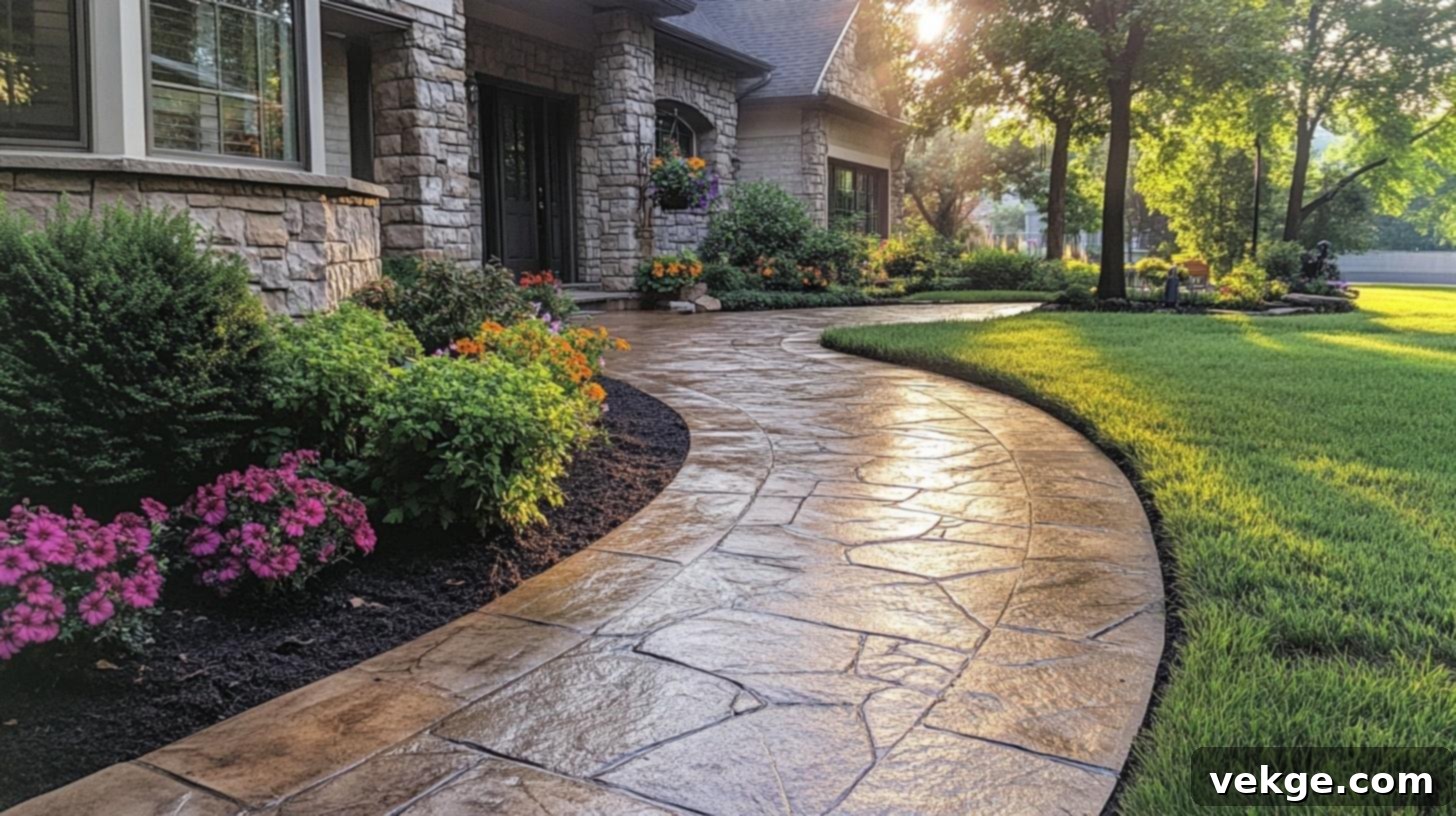
This timeless design masterfully replicates the sophisticated appearance of large, irregularly shaped slate tiles, arranged in a visually pleasing, almost random pattern. By incorporating warm browns, deep tans, and subtle greys, the Ashlar slate pattern with earth tones creates a clean, rich, and understated elegance. It’s a versatile choice that harmonizes beautifully with nearly any home exterior, from rustic farmhouses to more contemporary builds. If you desire a walkway that exudes strength, classic charm, and a refined yet welcoming feel, this pattern offers a grand statement without being overly ornate. Its naturalistic texture also provides good slip resistance.
2. Cobblestone Fan Pattern for Old-World Charm

Transport yourself to the charming streets of an ancient European village with the captivating cobblestone fan pattern. This design features individual “stones” laid out in graceful, curving fan shapes, creating a sense of movement and artistry. The pattern evokes a handcrafted, cozy, and distinctly historic ambiance, instantly adding significant character and warmth to your walkway. It’s particularly well-suited for homes with traditional, colonial, or Mediterranean architectural styles. If you appreciate rich history and desire a pathway that tells a story and truly stands out, the cobblestone fan pattern is an exceptional choice that will impress.
3. Wood Plank Texture for Rustic Pathways
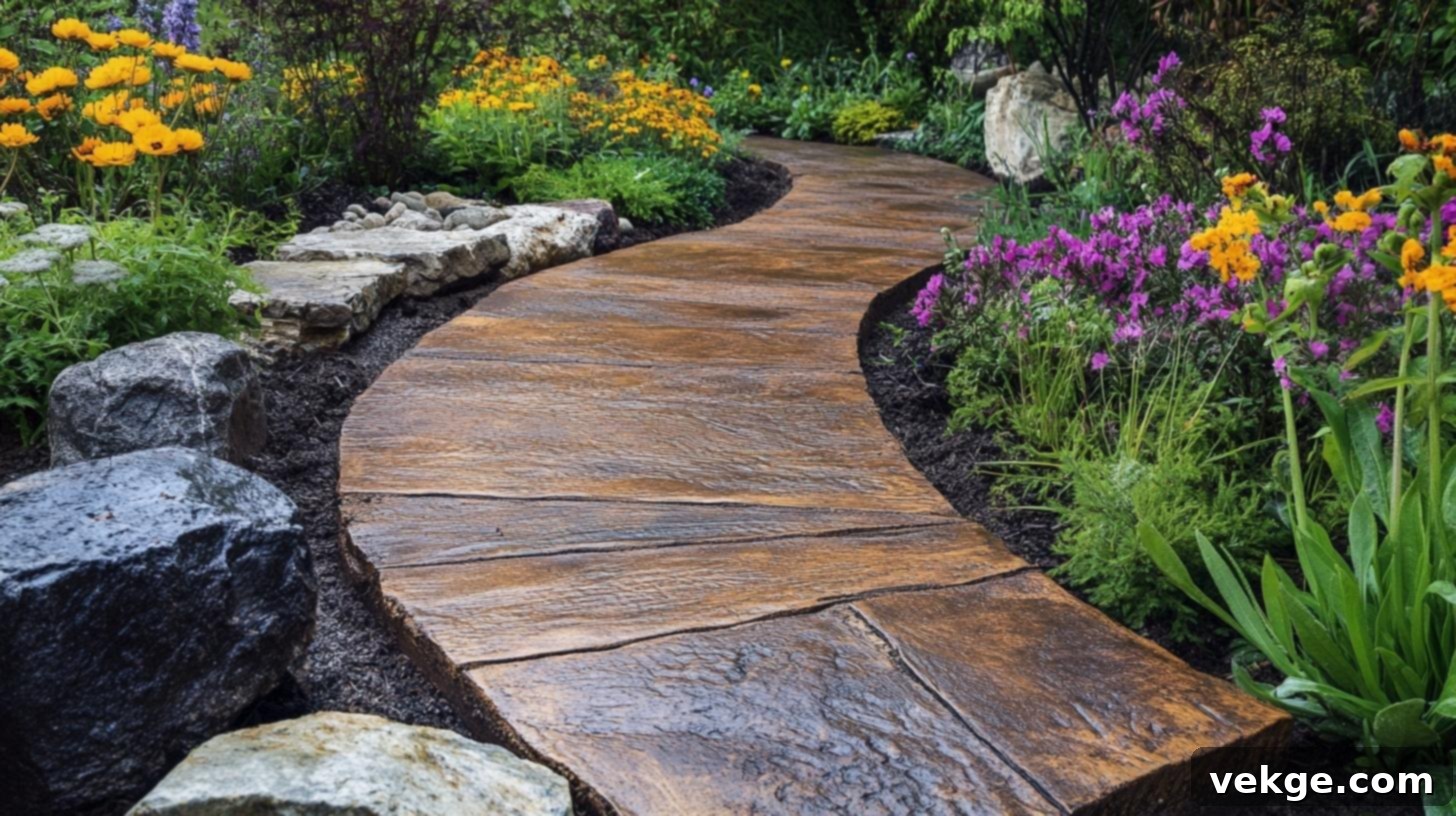
Achieve the inviting look of natural timber with the durability of concrete using a wood plank texture. This innovative style meticulously replicates the grain, knots, and even subtle imperfections of real wood, making your walkway appear as if it’s crafted from authentic lumber. It’s an ideal choice for enhancing cottage-style homes, farmhouses, or any landscape seeking a warm, rustic, and organic feel. You gain the aesthetic appeal of aged wood without any of the concerns associated with natural timber, such as rotting, splintering, or pest infestations. It truly offers the best of both worlds: natural beauty and robust, low-maintenance material.
4. Hexagonal Geometric Pattern for a Modern Touch
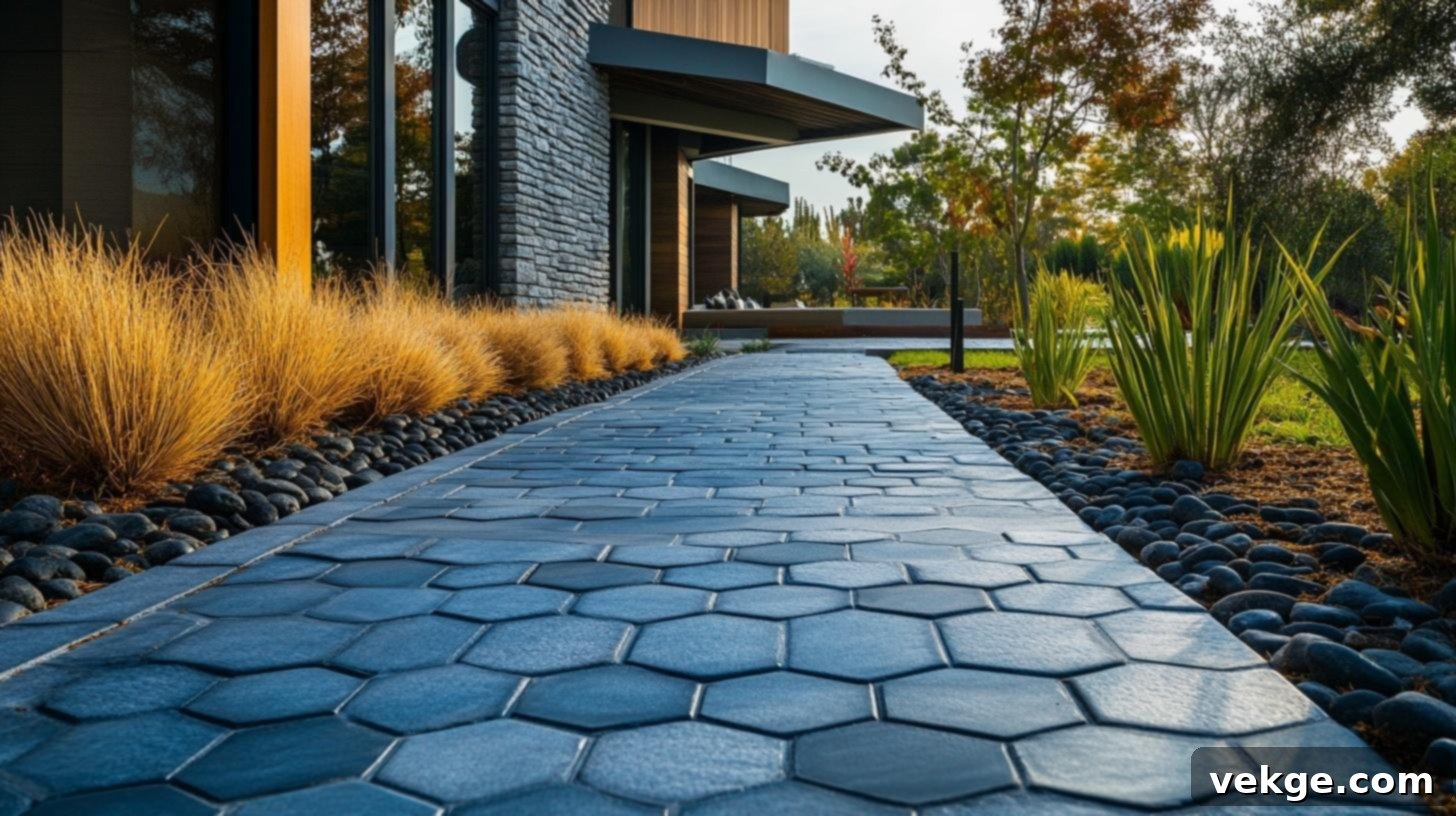
For those who favor sleek lines and contemporary aesthetics, a hexagonal geometric pattern delivers a bold and fresh statement. This design features crisp, angular shapes that interlock seamlessly, creating a visually dynamic and orderly surface. It’s a fantastic option for modern or minimalist homes, providing a clean, architectural look that instantly elevates the property’s curb appeal. The precise fit and strong lines offer a sense of sophistication and structured elegance. If you appreciate a tidy, distinctive design that makes a contemporary impact, this pattern provides your walkway with an intelligent and cutting-edge style.
5. Seamless Slate in Cool Gray Tones

Embrace understated elegance with the seamless slate pattern, which mimics the refined, smooth texture of natural slate stone. Presented in cool gray tones, this design creates a serene and sophisticated pathway that complements modern, urban, or industrial-chic homes particularly well. Its “seamless” nature means it lacks strong grout lines or distinct borders, allowing the path to feel expansive and continuous. The result is a calming, uncluttered aesthetic that is also incredibly easy to clean and maintain, consistently projecting a neat and polished appearance. This pattern is perfect for creating a sense of tranquil modernity in your outdoor space.
6. Mediterranean Tile-Inspired Patterns
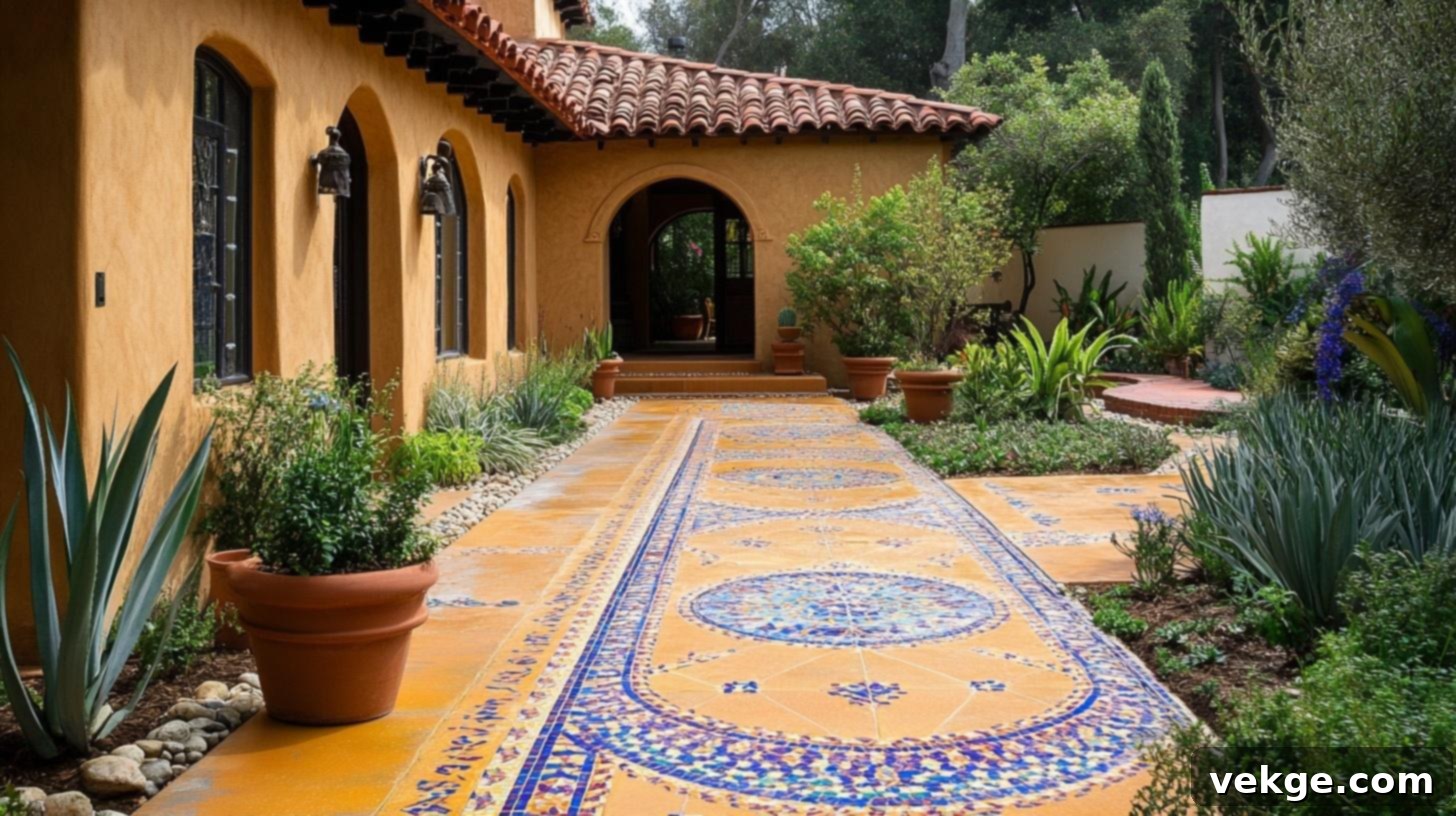
Infuse your outdoor area with vibrant character and a sun-drenched ambiance using Mediterranean tile-inspired patterns. These designs replicate the intricate, often colorful motifs found in the traditional tiles of warm, coastal regions. Featuring flowing curves, geometric shapes, and often bold hues, this style transforms your walkway into a bright, inviting, and truly unique feature. It’s especially impactful in patio areas, garden pathways, or spaces where you wish to introduce a lively splash of color and cultural flair. This design is exceptionally bold, eye-catching, and imbues your property with a rich, charismatic personality.
7. Herringbone Brick Layout with Antique Finish
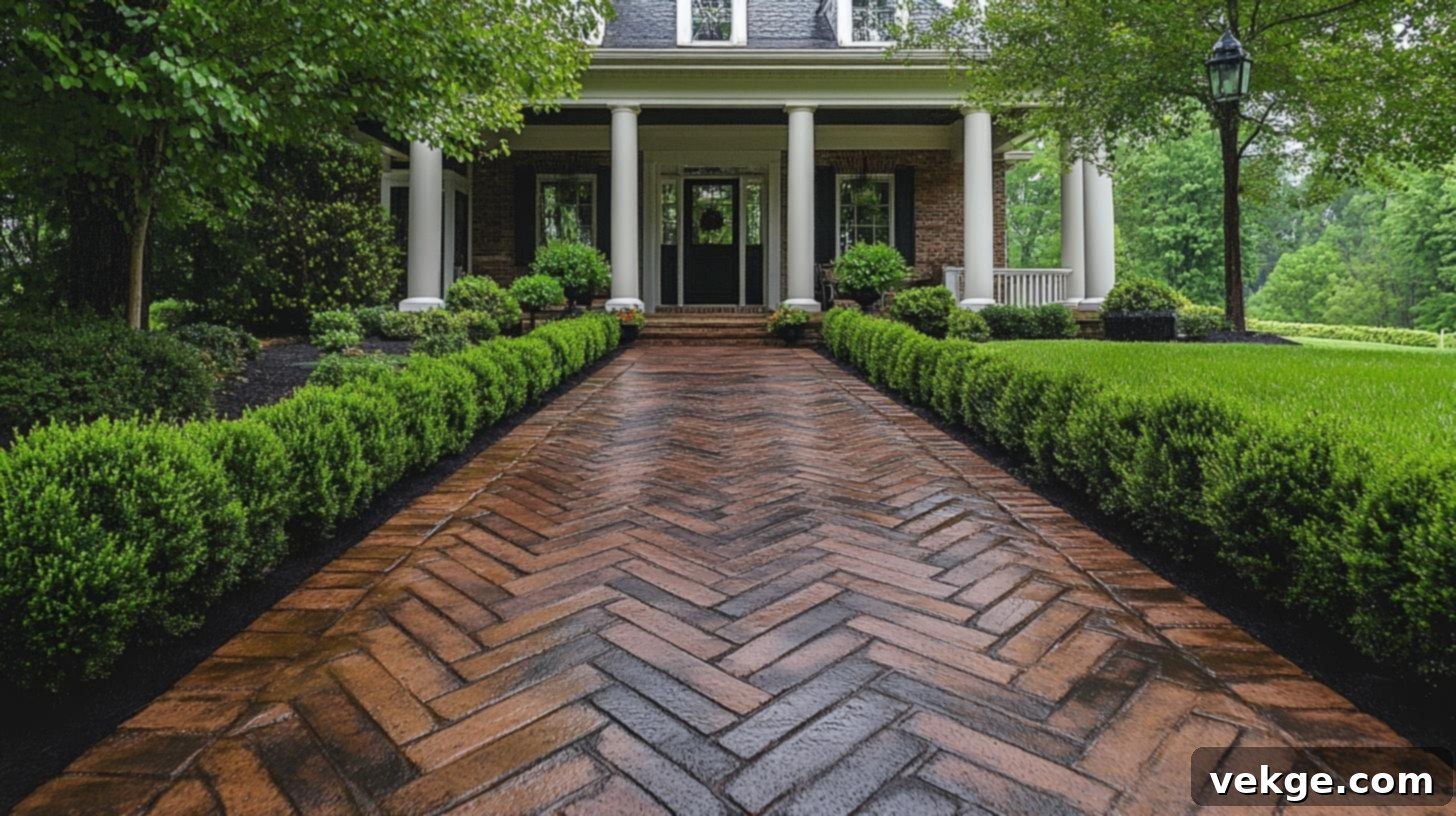
For a classic, time-honored look, the herringbone brick layout is an undeniable favorite. This pattern features rectangular “bricks” laid in a distinctive V-shape or zigzag formation, creating a visually appealing and incredibly strong surface. Applying an antique or weathered stain further enhances its appeal, giving it the rich, aged patina of authentic, centuries-old brick. This style is superb for homes that appreciate old-world charm, traditional architecture, and clean, orderly lines. The herringbone pattern brings a sense of refined balance and enduring quality to any outdoor space, offering both aesthetic beauty and exceptional structural integrity.
8. Natural Stone-Look with Multi-Color Layers
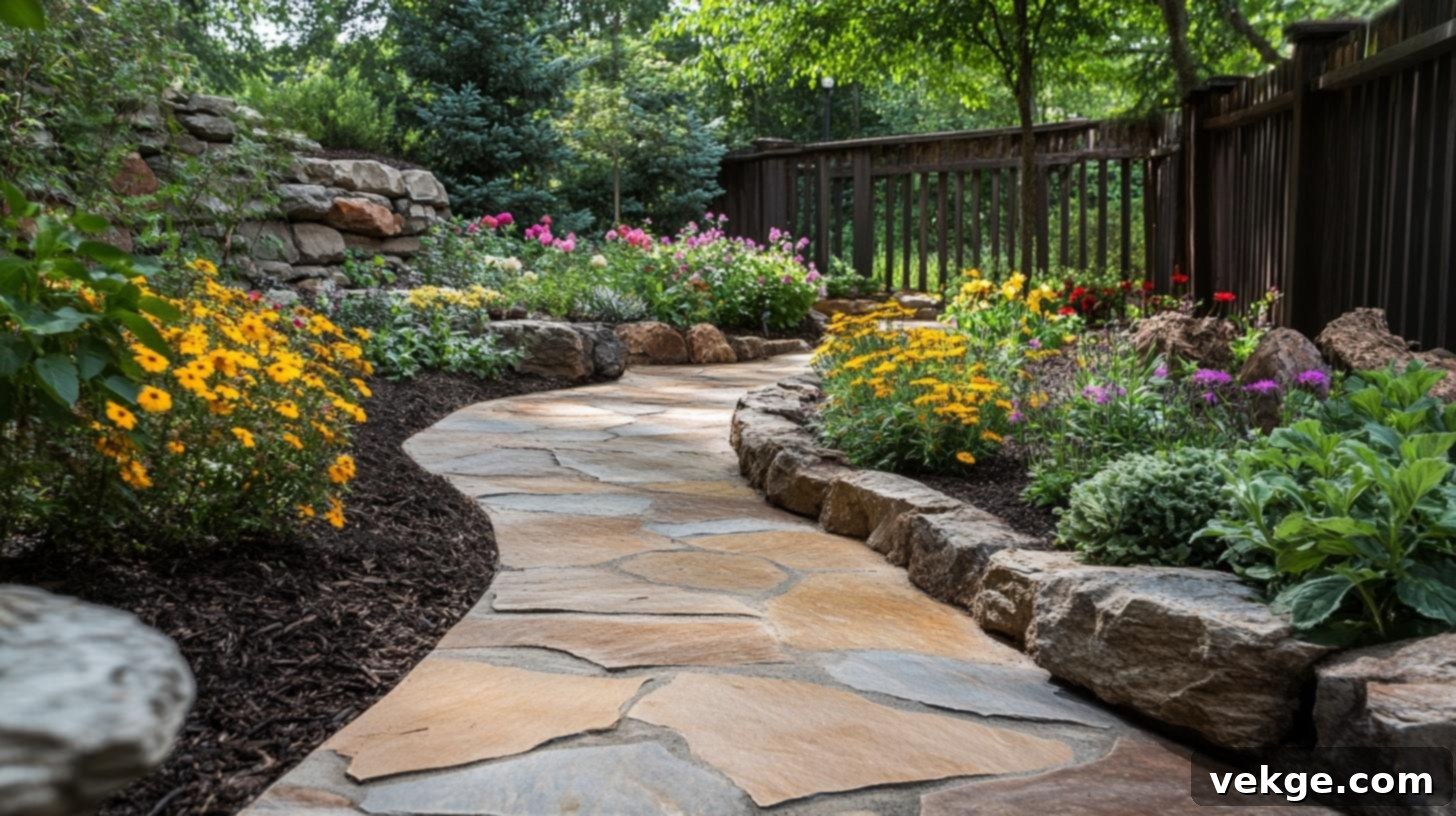
Capture the organic beauty of real stone with a multi-color layered design. This technique expertly mimics the varied textures, uneven shapes, and rich, layered hues found in natural flagstone or bluestone. The magic lies in using multiple color applications and stamping mats to create depth and variation, resulting in a remarkably authentic appearance at a fraction of the cost and maintenance. The intentionally random shapes and diverse color palette contribute to a relaxed, earthy, and inherently natural aesthetic. If your goal is to create a pathway that feels like it sprung directly from nature itself, this robust and beautiful option is a strong contender.
9. Exposed Aggregate Edge with Decorative Border
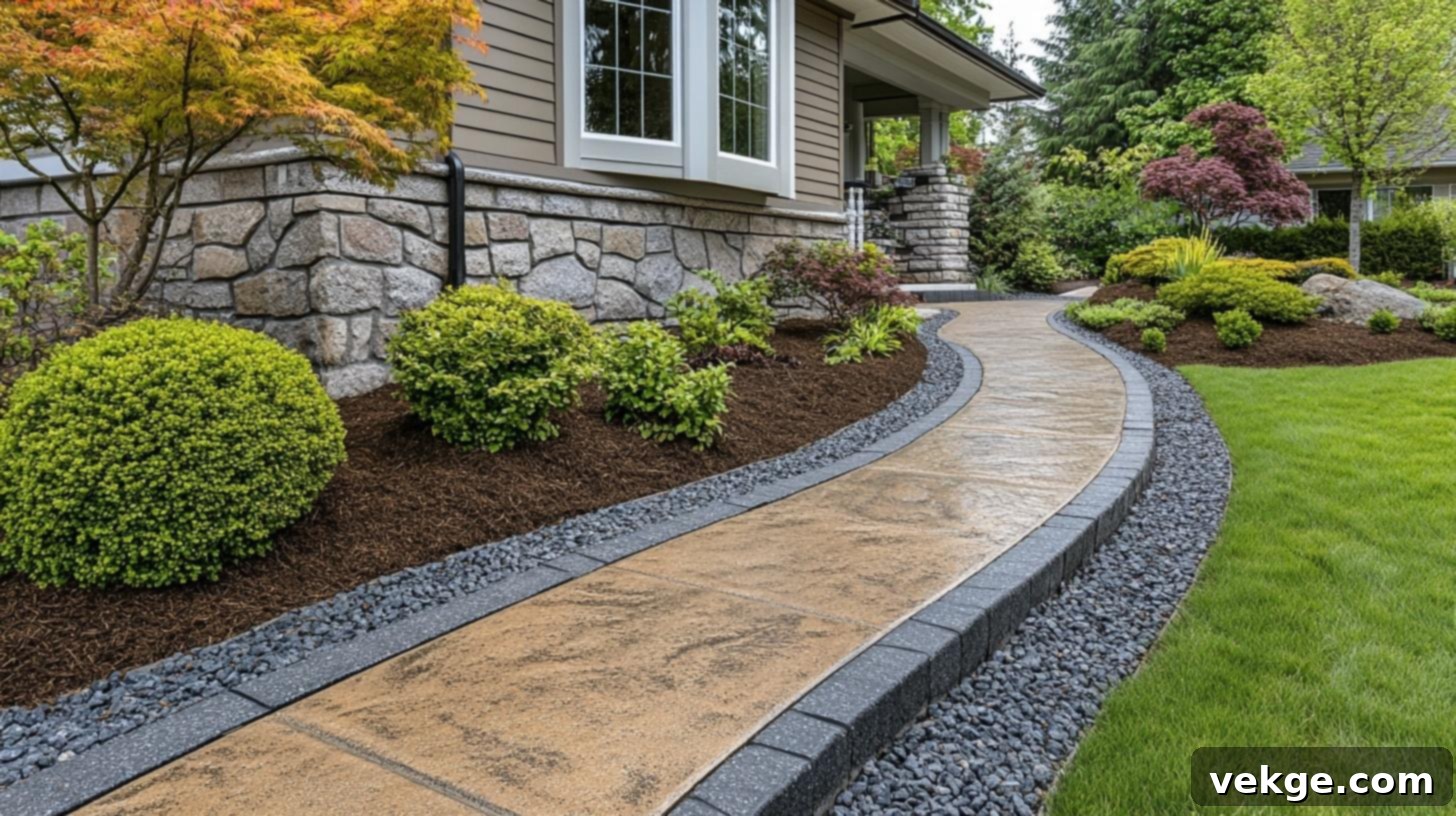
Elevate the visual interest of your walkway by combining two distinct concrete finishes: smooth stamped concrete for the main path and a textured exposed aggregate for the borders. This design involves revealing small, colorful stones and pebbles embedded within the concrete along the edges, creating a gritty yet decorative frame. The central path remains smooth and comfortable for walking, while the aggregate border adds a striking visual contrast, enhanced traction, and a touch of organic texture. It’s an excellent way to introduce a multi-dimensional look, boosting both the safety and aesthetic appeal of your pathway by blending functional grip with sophisticated style.
10. Stamped Concrete with Inlaid Grass or Gravel Joints
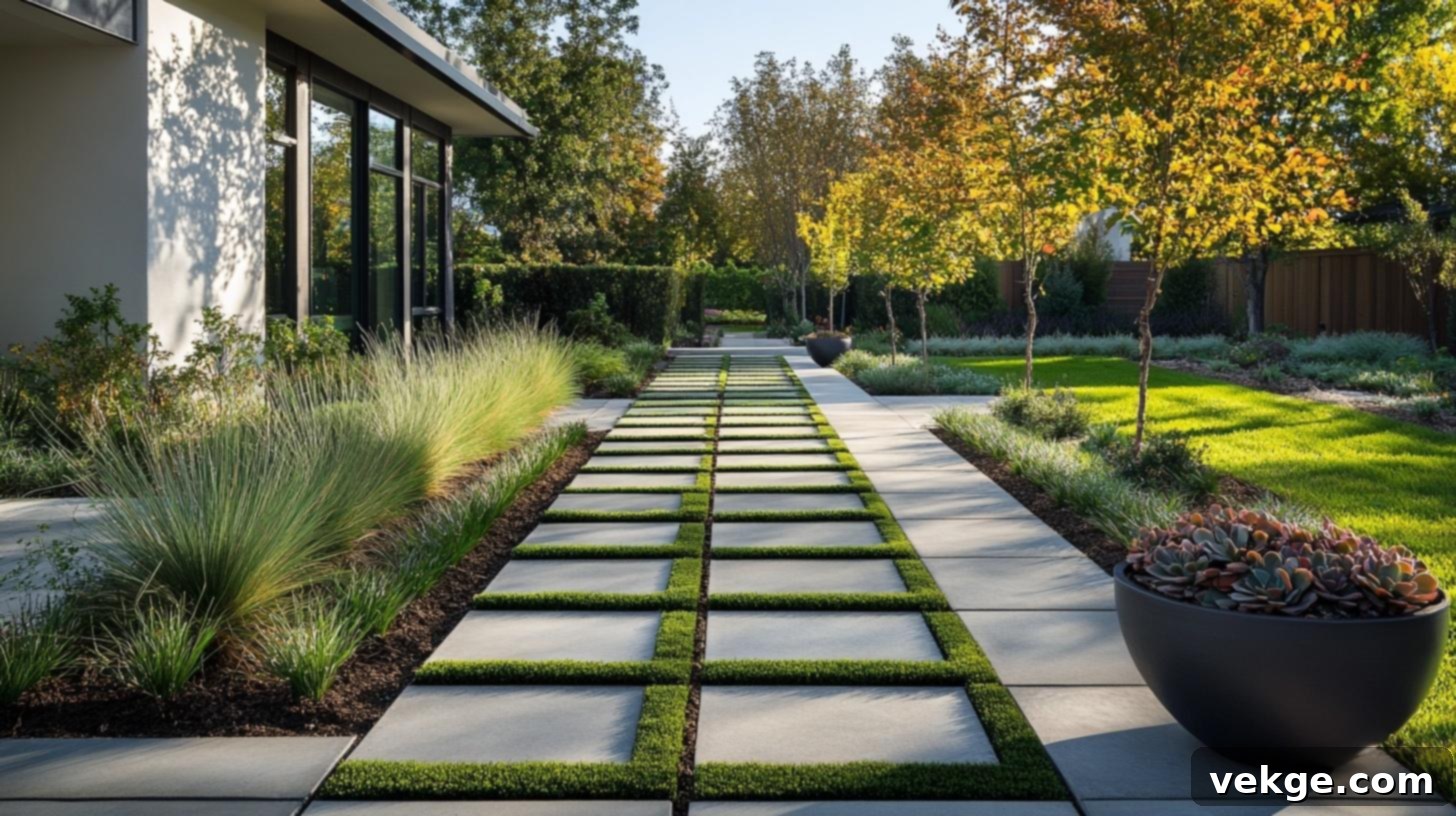
For a pathway that seamlessly integrates with your natural landscape, consider incorporating inlaid grass or gravel into the joints of your stamped concrete. This design breaks up the expansive hard surface, introducing soft, natural elements between sections of the concrete pattern. Thin strips of lush grass or decorative gravel not only add visual interest and a more organic feel but also serve a practical purpose by improving water drainage. This style is particularly effective in garden settings or areas where you wish to blend your walkway harmoniously into the surrounding greenery, creating a charming and eco-friendly connection with nature.
11. Stamped Walkway with LED Inset Lights
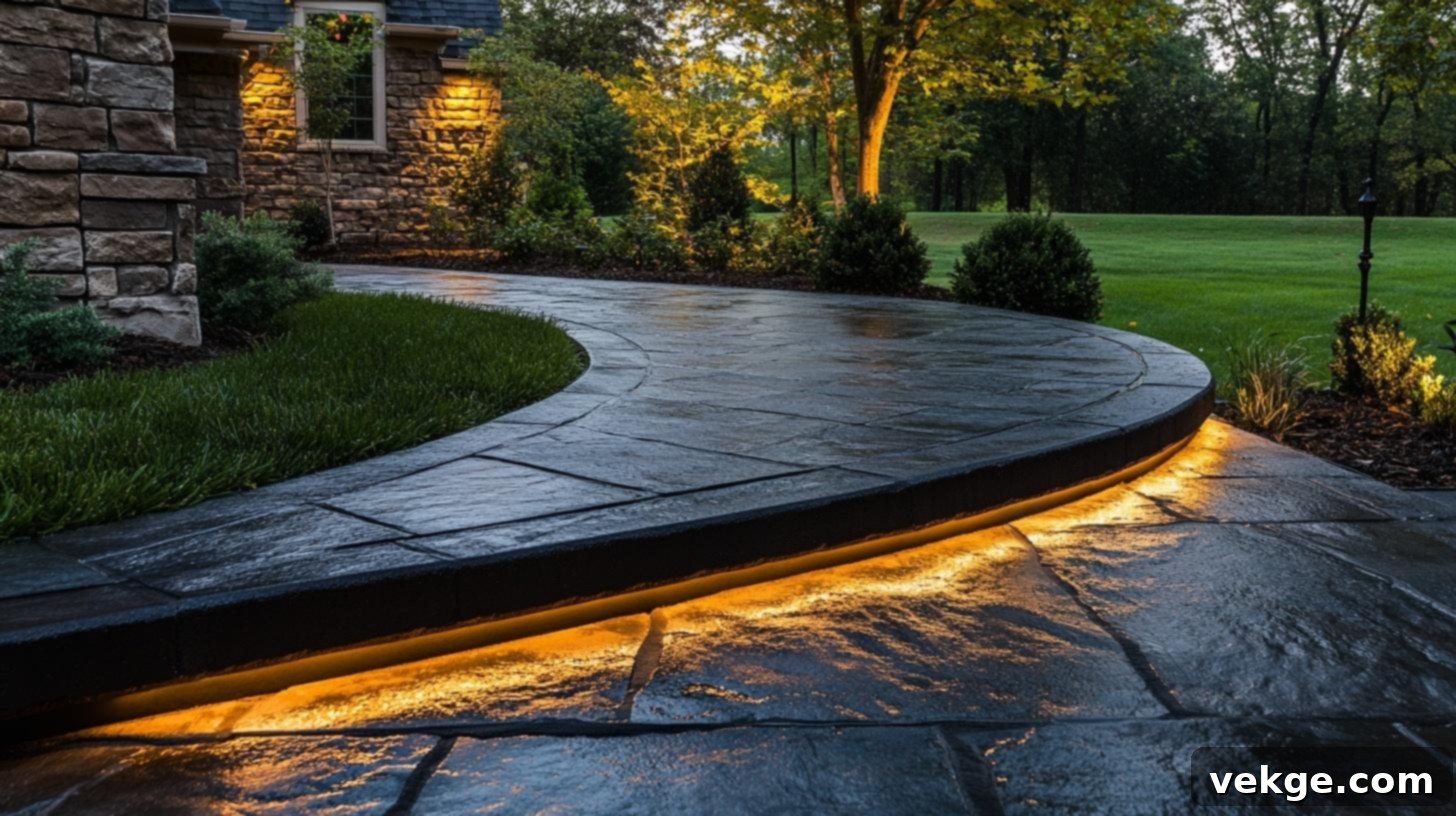
Combine practicality with modern elegance by integrating subtle LED lights directly into your stamped concrete walkway. These small, durable lights are strategically placed along the path’s edge or within the pattern, providing gentle illumination that enhances nighttime safety and creates a sophisticated ambiance. Built to withstand various weather conditions, these inset lights offer a sleek, unobtrusive lighting solution that eliminates the need for external fixtures. This design is a smart, contemporary way to add both functional safety and an undeniably stylish, inviting glow to your outdoor space, making your pathway accessible and beautiful after dark.
12. Stamped Concrete with Mosaic Tile Accents

Unleash your artistic side by incorporating vibrant mosaic tile accents into your stamped concrete pathway. This unique design allows you to embed small pieces of colorful ceramic, glass, or natural stone tiles at strategic points along the walkway. These mosaic inlays can form intricate patterns, depict charming images, or simply add splashes of color and texture, transforming your path into a personalized work of art. It lends a distinctive, handmade, and highly customized feel to your outdoor area. If you’re a fan of unique art or simply desire a walkway that stands out with individual flair, this creative option is a fantastic choice.
13. Garden Walkway with Leaf-Imprint Texture
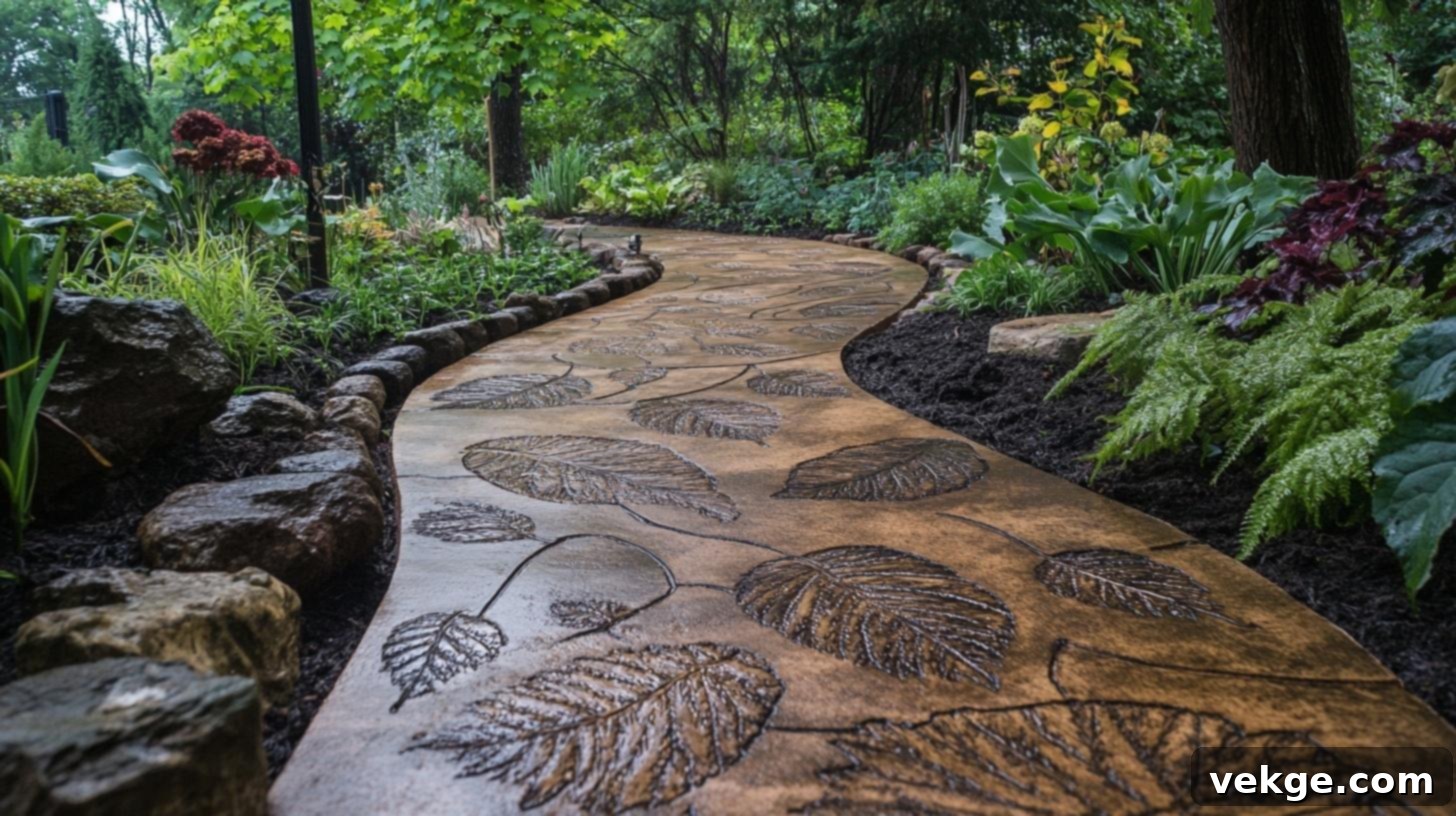
Bring the gentle beauty of nature directly onto your path with a leaf-imprint texture. This enchanting design utilizes specialized stamping mats shaped like various leaves, which are pressed into the wet concrete to create detailed, organic patterns. It’s an absolutely perfect choice for garden pathways, naturalized areas, or homes surrounded by lush landscaping. You can opt for realistic leaf patterns to create a soft, playful, and whimsical feel, integrating your walkway seamlessly with the botanical elements of your yard. This subtle yet charming texture adds a tranquil, nature-inspired touch without requiring actual plants on the walking surface.
14. Meandering Path with Multi-Stamp Zones
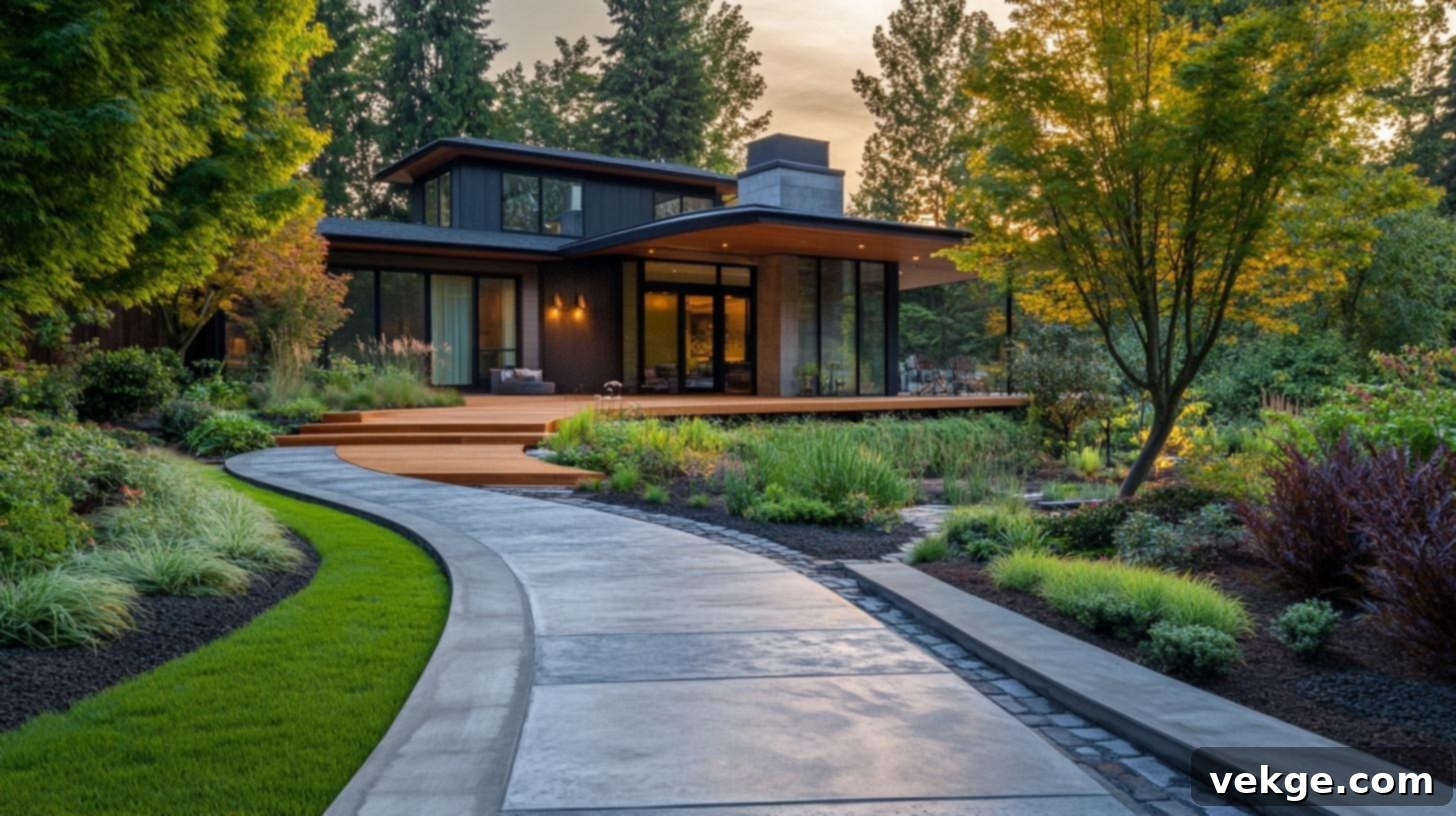
For longer, winding pathways, a multi-stamp zone approach adds dynamic visual interest and prevents monotony. Instead of applying a single pattern throughout, this design involves segmenting the path and utilizing different stamped patterns in various zones. For example, you might start with an Ashlar slate pattern near the house, transition to a wood plank texture through a garden, and conclude with a charming cobblestone effect at the gate. This creative technique makes a meandering path feel more like a journey, with each section offering a unique visual experience. It’s an excellent way to introduce variety and distinct character along an extended outdoor route.
15. Budget-Friendly DIY with Modular Stamp Mats
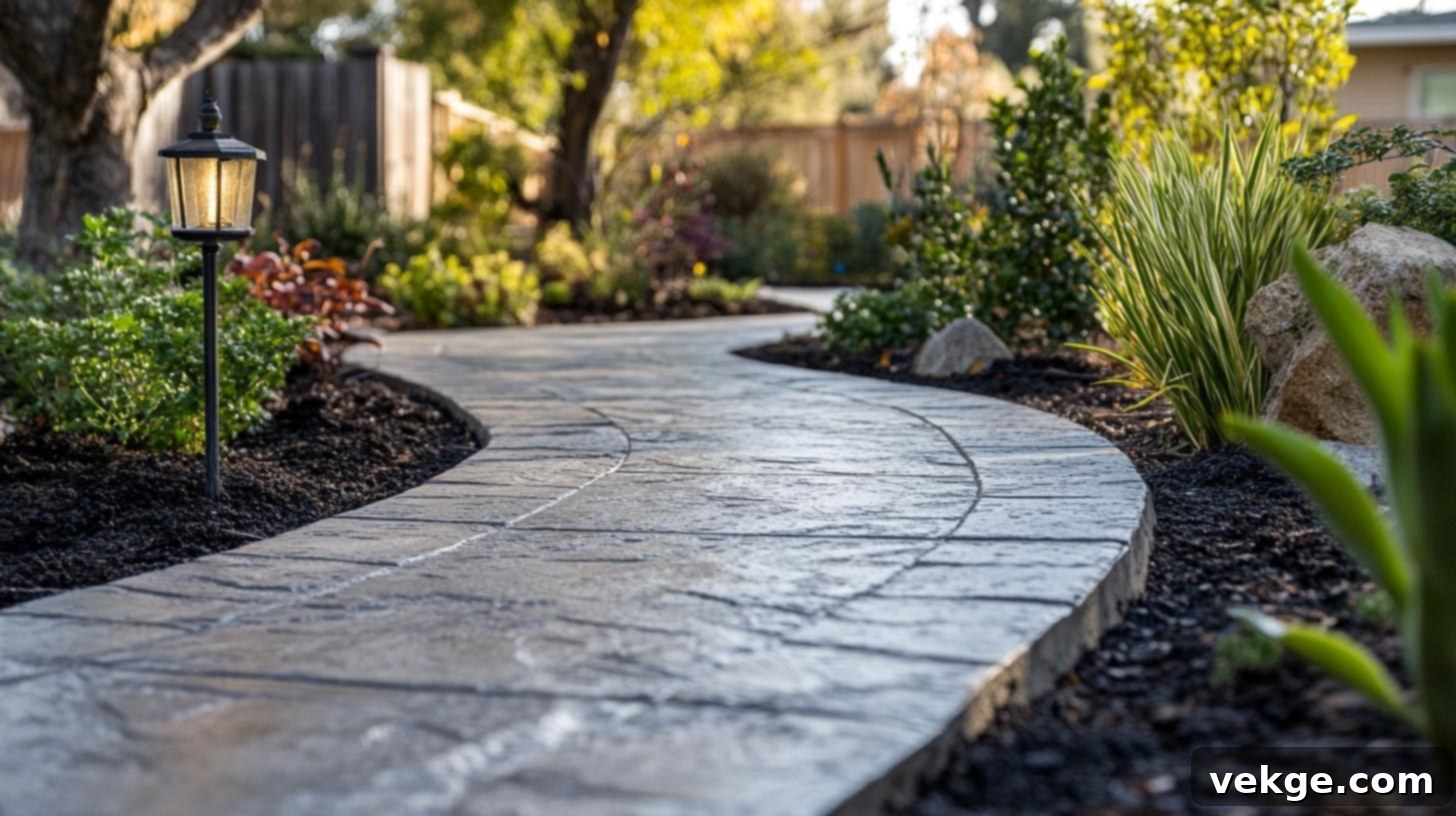
If you’re a hands-on homeowner looking for a cost-effective way to enhance your property, a DIY stamped concrete project using modular stamp mats is an excellent option. These user-friendly mats or rollers come with pre-designed patterns, making the stamping process relatively simple. After pouring and leveling your concrete, you merely press the mats into the wet surface to transfer the desired texture and pattern. This method is manageable enough for a dedicated weekend project and significantly reduces labor costs, allowing you to achieve a professional-looking design without hiring a specialized crew. It’s an empowering way to create a beautiful, custom walkway on a budget.
Choosing the Right Stamped Concrete Pattern for Your Space
Selecting the ideal stamped concrete pattern is crucial for ensuring your walkway not only looks fantastic but also complements your home’s overall aesthetic and the specific dimensions of your outdoor area. It’s about creating harmony and visual balance.
Consider your home’s architectural style first. For modern or contemporary residences, clean and minimalist designs work best. Large, understated patterns like seamless slate, bold hexagons, or smooth wood planks can enhance the sleek lines and uncluttered appeal of these homes. They contribute to a sophisticated, current look without competing for attention.
Conversely, traditional or historic homes often pair beautifully with classic patterns that evoke a sense of heritage and detailed craftsmanship. Cobblestone, herringbone brick, or Ashlar slate patterns add charm, intricate detail, and a timeless quality that feels right at home with established architectural styles. These designs can reinforce a sense of warmth and history.
The size and shape of your walkway also play a significant role. For smaller, narrower paths, opting for smaller or tighter patterns is generally advisable. Overly large patterns can overwhelm a confined space, making it feel even smaller and potentially out of proportion. They might also appear repetitive too quickly. In contrast, for expansive walkways or broad entrance paths, larger patterns truly shine. They fill the space effectively, allowing the pattern to unfold and be appreciated without feeling cramped or overly busy. The goal is to ensure the scale of the pattern feels balanced and proportional to the surrounding environment, making your stamped concrete walkway feel like a natural and integral part of your home’s landscape design.
Maintenance and Longevity of Stamped Concrete Walkways
One of the significant advantages of stamped concrete is its relatively low maintenance, ensuring your walkway retains its beauty for years to come with just a few simple steps. Proper care not only preserves its aesthetic appeal but also extends its structural integrity.
To keep your stamped concrete clean, regular sweeping is essential to remove dirt, leaves, and other debris that can accumulate and potentially cause staining. Every few weeks, give it a good rinse with a garden hose. For deeper cleaning or to tackle stubborn grime, a gentle soap or a dedicated concrete cleaner combined with a soft-bristle brush can work wonders. Avoid harsh chemicals or high-pressure washers, which can damage the sealant and surface over time.
The most critical step for preserving the color, pattern, and protective qualities of your stamped concrete is regular resealing. Experts recommend reapplying a high-quality concrete sealant every 2–3 years, or more frequently in high-traffic areas or harsh climates. The sealant acts as a protective barrier against moisture penetration, UV rays, and abrasion, preventing fading, staining, and surface wear. Without adequate sealing, your concrete will be more vulnerable to the elements, leading to premature deterioration and a dull appearance.
During winter months, exercise caution with de-icing agents. Avoid using rock salt or corrosive ice melts, as these chemicals can aggressively attack and compromise the concrete surface and its sealant. Instead, use sand for traction or opt for magnesium chloride-based de-icers, which are generally safer for concrete. When clearing snow, use a plastic shovel or a snowblower with a plastic blade to prevent scratching or chipping the surface.
Should minor cracks or chips appear over time, address them promptly. Small repairs using concrete patching compounds can prevent them from expanding and becoming larger, more problematic issues. Timely maintenance and quick fixes are key to ensuring your stamped concrete walkway remains a durable, attractive asset to your property for many decades.
Common Stamped Concrete Mistakes to Avoid
While stamped concrete offers incredible versatility and durability, achieving a flawless, long-lasting finish requires attention to detail. Avoiding common pitfalls during installation and ongoing care is crucial. Here’s a list of critical mistakes to watch out for, along with why they matter:
- Poor Stamping Technique: Applying uneven pressure with the stamping mats or mistiming the stamping process (when the concrete is too wet or too dry) results in inconsistent patterns, blurry textures, or even damaged impressions. This compromises the entire aesthetic.
- Incorrect Release Agent Application: A release agent prevents the stamping mats from sticking to the wet concrete and often imparts a secondary color. Using the wrong type, too little, or applying it unevenly can lead to mats adhering to the concrete, pulling up the surface, or creating patchy, undesirable color variations.
- Skipping or Improper Sealing: This is perhaps the most critical mistake. Without a proper, high-quality sealant applied and maintained, stamped concrete is highly susceptible to fading from UV exposure, staining from oils or spills, water penetration (leading to freeze-thaw damage), and premature wear. The sealant protects the finish and ensures longevity.
- Lack of Expansion Joints: Concrete naturally expands and contracts with temperature changes. Without strategically placed expansion joints, the stress builds up, leading to uncontrolled, unsightly cracks. These joints are essential for managing movement and preventing random fracturing.
- Inconsistent Color Matching or Mixing: Achieving uniform and vibrant color relies on precise pigment measurement and thorough mixing. Poor color matching or inadequate mixing can result in blotchy areas, mismatched sections, or a dull, unappealing overall appearance that detracts from the design.
- Inadequate Base Preparation: The foundation beneath your concrete is paramount. An uneven, improperly compacted, or poorly drained sub-base can lead to sinking, settling, and cracking of the concrete slab over time. A stable base ensures long-term stability and prevents structural failures.
- Stamping When Concrete is Too Hard: Timing is everything in concrete stamping. If you wait too long after pouring, the concrete begins to set and becomes too hard for the stamping mats to create clear, defined impressions. This results in weak, shallow, or incomplete patterns that lack detail and depth.
- Using Harsh Chemicals or Salt for De-icing: As mentioned, harsh chemicals, especially rock salt, can aggressively corrode and degrade the concrete surface and its sealant, leading to pitting, spalling, and discoloration, drastically shortening the walkway’s lifespan.
By understanding and actively avoiding these common mistakes, you can significantly increase the likelihood of a successful, beautiful, and durable stamped concrete walkway installation that you’ll enjoy for many years.
Conclusion: Your Path to a Beautiful Stamped Concrete Walkway
I genuinely hope these extensive stamped concrete walkway ideas have sparked your imagination and shown you just how accessible and rewarding it can be to create an outdoor space that truly reflects your style. When I first embarked on my own journey, the possibilities seemed daunting, but with the right inspiration and information, the process became clear and exciting.
Now it’s your turn to envision and select the perfect pattern and color scheme that harmonizes with your home and landscape. Remember, a little thoughtful planning and consistent care are the secret ingredients to maintaining the stunning appearance and longevity of your new walkway for many years to come.
My final piece of advice: don’t rush the process, whether you’re doing it yourself or working with professionals. Quality work takes time, and the results will be a beautiful, enduring addition to your property. If you’re eager for more design insights, practical tips, or real-life project examples, be sure to explore my other blogs. There’s always more to learn and countless ways to transform your outdoor living spaces!
